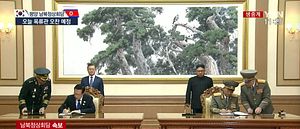On Wednesday, the defense ministers of North and South Korea signed a major agreement on military tension reduction and conventional arms control in Pyongyang. As had been widely anticipated in the lead-up to the fifth inter-Korean summit this week, the agreement includes provisions that apply both to the disputed western maritime boundary known as the Northern Limit Line (NLL) and troop positions along the Demilitarized Zone (DMZ) separating the two countries.
The agreement builds on the agenda set out in the inter-Korean Panmunjom Declaration agreed by South Korean President Moon Jae-in and North Korean leader Kim Jong Un on April 27 this year and follows months of protracted working-level military-to-military talks. It will be overseen by a joint inter-Korean military committee.
On Wednesday, at a press conference in Pyongyang, Moon touted the agreement as removing “all threats across the peninsula” that could start a war. Both Moon and Kim are working to secure a declaration to end the Korean War by the end of the year—a move that would require buy-in from the United States as well.
On land, Wednesday’s agreement has several outcomes, including, most prominently, the creation of a 10 kilometer wide buffer zone on either side of the Military Demarcation Line (MDL), the border separate the two. Within this buffer zone, neither side will conduct artillery drills or major military maneuvers, reducing the possibility of a miscalculation leading to a crisis.
Additionally, both sides will disarm their personnel at the Joint Security Area (JSA) on the DMZ and, on a trial basis, pull back guard posts. Beginning in November, both sides will also cease other military exercises and drills in close proximity to the MDL. The agreement on Wednesday does not include a permanent withdrawal of deployed artillery pieces—a possibility that both sides explored, but ultimately failed to agree on earlier in the summer.
At sea, the two sides will establish a maritime buffer zone, along both the NLL in the west and the eastern maritime limit. Similarly to the land buffer zone, naval drills and coastal artillery drills will be prohibited in these waters. The agreement will not prohibit routine patrols by both sides near the NLL or civilian fishing activity.
Meanwhile, in the air, the two sides announced a military no-fly zone extending to the west and the east of the MDL boundary, with some exemptions for emergency scenarios. In earlier working-level talks, North Korea had reportedly proposed a no-fly zone extending north and south of the MDZ akin to the land buffer zone, but South Korea had rejected the proposal.
Beyond the territorial limitations announced on land, sea, and air, the inter-Korean military agreement includes a joint project to remove landmines from the DMZ as well as a project to retrieve the remains of Korean War dead in the DMZ. The latter will begin in April 2019.

































